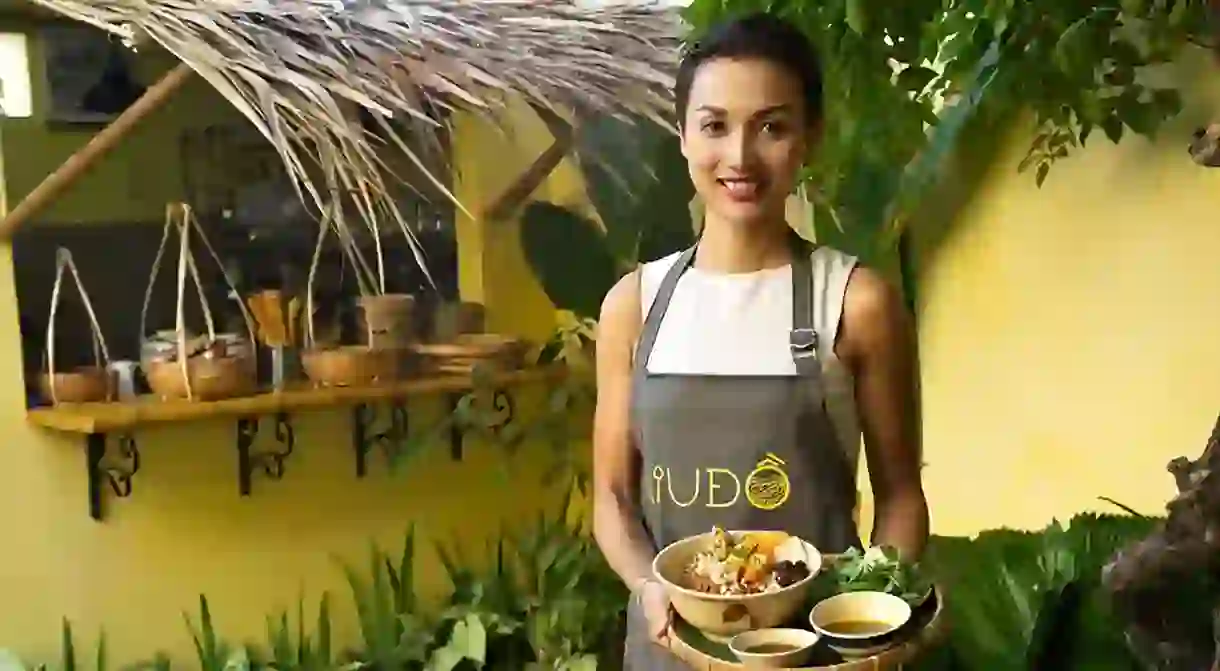Learn How To Cook Hoi An’s Staple Dish – Mì Quảng Noodles – From a Master Chef

With travel to Vietnam still restricted, the next best thing is to bring the taste of Hoi An to you. Chef, and star of Vietnam’s MasterChef, Carol Pham tells us how to make one of Hoi An’s most beloved dishes from the comfort of your own home.
“The way people came together during the crisis is why I love Vietnam. When something difficult happens in Vietnam, we pull together. That is how Vietnamese people work,” says Carol Pham, runner-up on Vietnam’s version of MasterChef in 2015. She spent lockdown – which ended with zero casualties and only around 270 cases – cooking special meals for those in the hospital recovering from the virus.
“For lunch, we cooked salad and some soup and some eggs. For dinner, we made corn and chicken soup with fresh spring rolls. Normally, if you’re cooking for 200 people, you wouldn’t cook something as detailed as that, but the idea is we’re trying to cook something with care that people can appreciate. They say coronavirus is a bit like the flu, so I wanted to make some recipes with garlic and spices to build people up and make them healthy. They feel that someone cares and wants to get them better. We need to support people during this time, and they need food that will make them feel warm and loved!”
Carol has made a name for herself by recreating mì quảng, the famous noodle dish of Central Vietnam, available on street corners throughout Hoi An and Da Nang. It’s one of the few dishes to be named after the province where it’s made. Mì means noodles in Vietnamese and quảng refers to Quảng Nam Province.

Her noodle restaurant in Da Nang is in the front yard of her house and painted in bright yellow, as is the tradition in Hoi An and its surrounding towns where she grew up.
Today, with the lockdown over and restaurants reopened, she’s invited us in for lunch to show us how you can cook her noodles at home.
Picking the right ingredients
To cook mì quảng noodles you will need:
– Onion (Carol uses a special small onion called nen that can only be found in Quảng Nam, but a normal onion will work fine with beef or fish)
– Meat (fish, chicken or beef)
– Rice noodles
– Cinnamon
– Beef stock
– Cloves
– Ground pepper
– Your choice of vegetables
– Peanuts
– A rice cake
The most important aspect of making mì quảng is sourcing the right ingredients. Carol prefers handmade rice noodles made from high-quality rice, but rice noodles can be hard to come by. Fortunately, Carol says you can use egg noodles, but “remember that we use rice noodles as they aren’t as flavourful so that the dish doesn’t become overpowered. With egg noodles, try to make the soup lighter in flavour, less thick.’’
In terms of veggies, Carol says don’t be afraid to experiment and adapt the dish to your own taste. “Create your own flavour. I love rocket in noodles. But in Vietnam, it’s too expensive, and Vietnamese people don’t really have a taste for it.”

The herbs and spices are also important. Carol loves using cinnamon in her beef noodles because it gives them a distinctive flavour, but there is plenty of room for experimenting. “Don’t be afraid to fail. Try it and see if it works.”
“Before MasterChef, I had no knowledge of cooking. I didn’t go to any school, I never went to work in a restaurant,” says Carol. “I only cooked for friends and family, and somehow I knew I loved cooking but I didn’t know how to to do it… don’t be scared to try, don’t be scared to fail. Just try your best.”
Cooking the noodles
Carol says there are two things you need to remember when you are preparing your pan for the soup broth, the noodles and the freshly cooked meat: “Put sugar or salt onto the pan before you cook and wait until you hear that crackling, sizzling noise. That’s when you’ll know you are ready to add all the ingredients in the soup together.”
The second thing to remember is getting the temperature of the pan right.

“You learn from experience. When you read recipes in books, they say ‘Cook this for five minutes, stir for 10 minutes,’ but an experienced chef doesn’t do that. An experienced chef, a good cook understands that every pan is different, the temperature is not quite right or the room you are cooking in is different, so you need to judge for yourself. Look at the soup and how it’s boiling; taste it.”
After cooking up a storm until your noodles and meat are tender in the broth, don’t forget to season your soup with some peanuts, veggies of your choice and a rice cake that you can crack into small pieces and sprinkle into the bowl to soak up the flavour of the dish.













